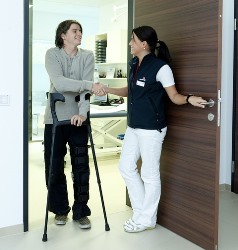How to Enroll In the Best LPN or LVN Training Program Near Coon Rapids Minnesota
 Once you have decided on a fulfilling career in the field of nursing, it's important that you select a Licensed Practical Nurse (LPN) school near Coon Rapids MN that will deliver the necessary instruction. If you reside in Texas or California, then you will be looking for a Licensed Vocational Nurse (LVN) school instead. There is no difference, aside from the names, between an LPN and an LVN. They both carry out the same job functions and work in medical facilities under the guidance of Registered Nurses (RN) or Doctors. However their functions do fluctuate depending on the state they practice in, which we will look at in the next section. When starting their search for schools, many future nursing students begin with those that are the closest to their residences or that are the least expensive. While tuition and location are relevant points to consider, they are not the only criteria that you should base your decision on. Other variables, for instance if the schools are accredited or have high pass rates on the licensing exam are very important as well. There are various other questions that you should ask potential schools before enrolling in a LPN or LVN training program that we will address later in this article. But to start with, let's have a look at the role of an LPN and what is involved in the instruction and licensing process.
Once you have decided on a fulfilling career in the field of nursing, it's important that you select a Licensed Practical Nurse (LPN) school near Coon Rapids MN that will deliver the necessary instruction. If you reside in Texas or California, then you will be looking for a Licensed Vocational Nurse (LVN) school instead. There is no difference, aside from the names, between an LPN and an LVN. They both carry out the same job functions and work in medical facilities under the guidance of Registered Nurses (RN) or Doctors. However their functions do fluctuate depending on the state they practice in, which we will look at in the next section. When starting their search for schools, many future nursing students begin with those that are the closest to their residences or that are the least expensive. While tuition and location are relevant points to consider, they are not the only criteria that you should base your decision on. Other variables, for instance if the schools are accredited or have high pass rates on the licensing exam are very important as well. There are various other questions that you should ask potential schools before enrolling in a LPN or LVN training program that we will address later in this article. But to start with, let's have a look at the role of an LPN and what is involved in the instruction and licensing process.
It Only Takes a Few Minutes to Start Your LPN or LVN Career Below
What does an LPN or LVN Do?

Licensed Practical Nurses have many functions that they complete in the Coon Rapids MN health facilities where they practice. As their titles imply, they are required to be licensed in all states, including Minnesota. While they may be accountable for overseeing Certified Nursing Assistants (CNA), they themselves generally work under the guidance of either an RN or a doctor. The medical facilities where they work are numerous and diverse, for instance hospitals, medical clinics, schools, and long-term care facilities. Virtually any place that you can encounter patients in need of medical assistance is their dominion. Every state not only controls their licensing, but also what work activities an LPN can and can't perform. So based on the state, their daily job functions may include:
- Measuring vital signs
- Administering medicines
- Initiating IV drips
- Observing patients
- Getting blood or urine samples
- Managing patient records
- Helping physicians or RNs with procedures
Along with their work responsibilities being regulated by each state, the health facilities or other Coon Rapids MN healthcare providers where LPNs work can additionally limit their job duties within those parameters. Additionally, they can work in different specialties of nursing, for instance long-term care, critical care, oncology and cardiology.
LVN and LPN Courses
There are essentially two scholastic credentials available that provide training to become an LPN or LVN near Coon Rapids MN. The one that can be completed in the shortest period of time, generally about twelve months, is the certificate or diploma course. The second choice is to attain a Practical Nursing Associate Degree. These LPN programs are broader in nature than the diploma option and usually require 2 years to complete. The benefit of Associate Degrees, along with offering a higher credential and more comprehensive training, are that they furnish more transferable credit toward a Bachelor's Degree in nursing. No matter the type of credential you pursue, it needs to be state approved and ideally accredited by the National League for Nursing Accrediting Commission (NLNAC) or some other national accrediting organization. The NLNAC warrants that the core curriculum adequately prepares students to become Practical Nurses, and that the majority of graduates pass the 50 state required NCLEX-PN licensing exam.Taking LVN and LPN Classes Online
 Enrolling in LPN programs online is becoming a more popular way to receive instruction and acquire a nursing certificate or degree in Coon Rapids MN. Certain schools will require attending on campus for part of the training, and almost all programs call for a certain amount of clinical rotation hours completed in a local healthcare center. But since the balance of the training can be accessed online, this alternative may be a more accommodating solution to finding the time to attend school for some students. Pertaining to tuition, some online degree programs are less expensive than other on campus options. Even additional expenses such as for commuting and study materials may be lessened, helping to make education more economical. And many online programs are accredited by U.S. Department of Education recognized organizations. Therefore if your work and family obligations have left you with little time to work toward your academic goals, perhaps an online LPN training program will make it easier to fit a degree into your busy schedule.
Enrolling in LPN programs online is becoming a more popular way to receive instruction and acquire a nursing certificate or degree in Coon Rapids MN. Certain schools will require attending on campus for part of the training, and almost all programs call for a certain amount of clinical rotation hours completed in a local healthcare center. But since the balance of the training can be accessed online, this alternative may be a more accommodating solution to finding the time to attend school for some students. Pertaining to tuition, some online degree programs are less expensive than other on campus options. Even additional expenses such as for commuting and study materials may be lessened, helping to make education more economical. And many online programs are accredited by U.S. Department of Education recognized organizations. Therefore if your work and family obligations have left you with little time to work toward your academic goals, perhaps an online LPN training program will make it easier to fit a degree into your busy schedule.
Questions to Ask LPN and LVN Schools
Now that you have decided on obtaining your LPN certificate, as well as if you will attend classes on campus or on the web, you can use the following guidelines to start narrowing down your choices. As you undoubtedly are aware, there are many nursing schools and colleges near Coon Rapids Mn as well as within Minnesota and throughout the United States. So it is essential to reduce the number of schools to choose from in order that you will have a manageable list. As we already mentioned, the location of the school and the expense of tuition are probably going to be the first two things that you will take into consideration. But as we also emphasized, they should not be your sole qualifiers. So before making your final choice, use the following questions to evaluate how your pick measures up to the other programs.
- Accreditation. It's a good idea to make sure that the certificate program in addition to the school are accredited by a U.S. Department of Education recognized accrediting agency. In addition to helping confirm that you obtain an excellent education, it may assist in obtaining financial aid or student loans, which are frequently not available for non-accredited schools near Coon Rapids Minnesota.
- Reputation. Check online rating services to see what the reviews are for all of the LPN schools you are considering. Ask the accrediting agencies for their reviews too. Additionally, check with the Minnesota school licensing authority to check out if there are any complaints or compliance issues. Finally, you can call some local Coon Rapids MN healthcare organizations you're interested in working for after graduation and ask what their judgements are of the schools as well.
- Internship Programs. The most effective way to obtain experience as a Licensed Practical Nurse is to work in a clinical environment. Essentially all nursing degree programs require a specific number of clinical hours be completed. A number of states have minimum clinical hour mandates for licensing as well. Find out if the schools have associations with nearby Coon Rapids MN community hospitals, clinics or labs and help with the placing of students in internships. Also, it's important that you choose a school that offers clinical training in the type of facility you are most interested in. For example, if you want training and experience in pediatric care, make sure that the school you choose provides adequate clinical rotation in an area Pediatric Hospital.
- Licensing Preparation. Licensing requirements for LPNs are different from state to state. In all states, a passing score is required on the National Council Licensure Examination (NCLEX-PN) together with graduation from an approved school. Certain states require a specific number of clinical hours be performed, as well as the passing of additional tests. It's essential that the school you are enrolled in not only delivers an outstanding education, but also preps you to satisfy the minimum licensing standards for Minnesota or the state where you will be practicing.
- Graduation and Job Placement Rates. Find out from the LPN programs you are considering what their graduation rates are as well as how long on average it takes students to complete their programs. A low graduation rate may be an indication that students were unhappy with the program and dropped out. It's also essential that the schools have high job placement rates. A high rate will not only confirm that the school has a good reputation within the Coon Rapids MN medical community, but that it also has the network of contacts to assist students attain employment.
- NCLEX Exam Pass Rate. Once you receive your certificate or diploma, you must sign up for and pass the National Council Licensure Examination for Practical Nurses (NCLEX-PN). Enrolling in a school with at least a 75% pass rate is highly preferred. Lower pass rates may indicate that a school’s program, curriculum or instructors are ineffective in teaching its students. You can find out from the school what their passing rate is for the last 5 years, or request the information from the State Board of Nursing.
Learn How to Become an LVN or LPN in Coon Rapids
Choose the Best Coon Rapids Licensed Practical Nurse Training
Deciding on the ideal Licensed Practical Nurse program is arguably the most crucial step to starting a new career in the healthcare industry. There are many variables that you should take into account when deciding on a nursing school. These variables will be prioritized differently depending on your existing career objectives, lifestyle, and financial situation. As we have highlighted in this article, it is important that you pick an LPN school and a certificate or degree program that are each accredited and have excellent reputations within the healthcare community. By using our list of qualifying questions, you will be able to produce a short list of schools to pick from so that you can make your final selection. And with the right degree and training, combined with your hard work and ambition to succeed, you can become a Licensed Practical Nurse in Coon Rapids Minnesota.
COON RAPIDS LPN OR LVN TRAINING | COON RAPIDS LPN OR LVN PROGRAMS
